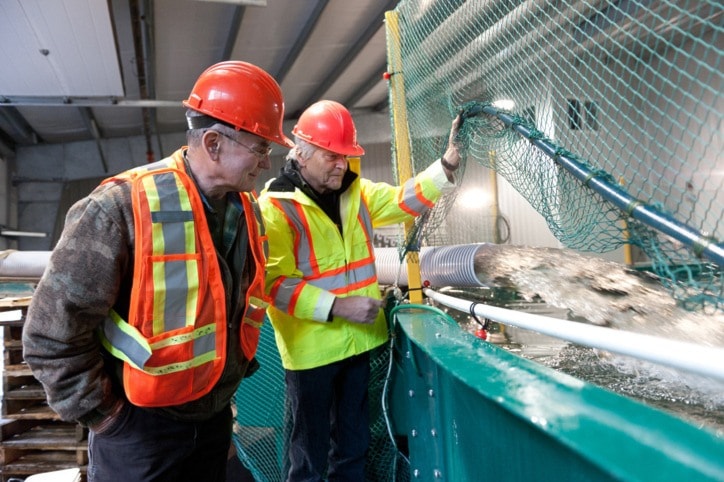PORT McNEILL—With a cry of "Here they come!" from beyond a roll-up shop door, the first fish arrived Monday afternoon to leap and circle in Canada's first land-based, closed-containment salmon farm devoted to growing Atlantic salmon to market.
"I hope this day will be marked down in history as the first day in our transition from open net to closed containment farming, to better protect our environment and the wild salmon," said Chief Bill Cranmer of the 'Namgis First Nation, which owns the 'Namgis Closed Containment Project on its territory just south of Port McNeill. "It's a very exciting day."
More than 23,000 atlantic salmon smolts were transferred from truck-mounted containers to the quarantine tank in the facility. They will spend the next four months there feeding, growing and undergoing a testing regimen before being transferred to one of five larger, grow-out tanks where they will be raised to market size in less than a year.
The smolts were provided by Marine Harvest, which operates a number of open net-pen fish farms on the B.C. coast.
"Marine Harvest is very much interested in the research and development of this facility, and the results we're going to be able to show in terms of growing these fish in a completely closed environment," said George Speck, 'Namgis senior administrator and member of the K'udas Limited Partnership, which administers the fish farm. "Everybody is interested in what we're doing."
The atlantic salmon farming industry will indeed be watching to see if the 'Namgis pilot project can succeed and develop into a commercial-scale operation, which will require as many as five modules of the type now in operation by the 'Namgis.
The pilot module utilizes a recirculation aquaculture system (RAS) in which almost all of the water used is treated and recycled back into the growing tanks. The solid wastes produced is sequestered and may be used as fertilizer.
It is the first such endeavour in Canada and one of the first in the world to apply the technology to Atlantic salmon, though the technology has been proven in other sites with species ranging from turbot and tilapia to sturgeon and Pacific salmon.
"I think we're the leaders in this industry right now," said Speck. "We're going to be the first ones leading the pack in terms of growing fish in this kind of facility out to full size, on land."
"I'm sure these type of recirculating aquaculture systems will be expanded to other communities as we prove the viability of this type of growing of salmon," said Cranmer.
A report released earlier this month by the Standing Fisheries Committee recommended the federal government support the efforts toward closed containment aquaculture.
Proponents have cited negative impacts of open net-pen aquaculture on the marine environment, though the Fisheries Committee was noncommittal on the science.
Critics point to the higher capital costs of land-based aquaculture, and concerns that a complete move from ocean to land-based aquaculture could cost remote coastal communities jobs and economic benefit because land-based farms could locate close to cities that have favourable shipping facilities.
As a pilot project, the 'Namgis Closed Containment project has already paid dividends. From the time federal government funding was announced in January of 2012, through construction of the facility, the operators have already learned valuable lessons that will shave costs from the building of future modules.
At the same time, the technology of land-based fish farming continues to evolve at a rapid pace, to the extent that one day the fish farm could actually be growing much of the food for its residents.
The feed pellets to be given to the smolts in the 'Namgis quarantine tank will be made up of fish meal, fish oil and plant material, said Jackie Hildering, community liaison for the project. But RAS-grown fish require 30 per cent less feed than ocean-reared salmon, and they grow to market size in roughly half the time.
"As we move along we're going to try to encompass more of the advances in feed, where it's moving more and more to algae," said Hildering. "In an ideal world, we'll be able to capture all the effluent and use it to grow a food source, like ragworm, that we could then completely close the loop. So you're actually feeding the fish food you've grown on the site."
Funding for the project has come from a variety of governmental and non-profit sources, including the Province of British Columbia’s Investment Agriculture Foundation; Fisheries and Oceans Canada’s Aquaculture Innovation and Market Access Program; the Pacific Salmon Foundation; Tides Canada; Enterprising Non-Profits; Aboriginal Affairs and Northern Development Canada; and the SOS Marine Conservation Foundation.
